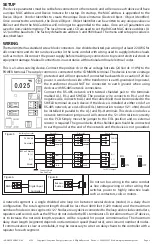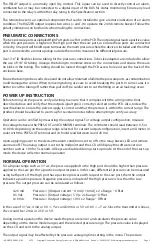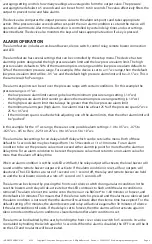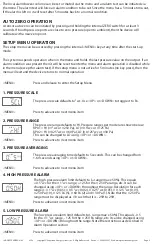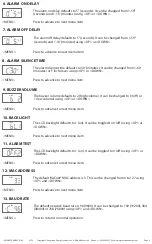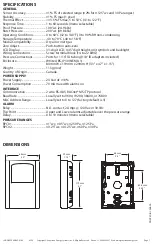
IN-GE-RPCXXXBAC-01-02 03/19
Page 3
Copyright © Greystone Energy Systems, Inc. All Rights Reserved Phone: +1 506 853 3057 Web: www.greystoneenergy.com
The RELAY output is a normally open dry contact. This signal can be used to directly control an alarm,
ventilation fan or may be connected to a digital input of the BAS for status monitoring. Ensure any load
connected to the relay is within the relay rating in the Specification section.
The remote buzzer is an optional component that can be installed to give a remote indication of an alarm
condition. The BUZZER output requires two wires (+ and -) to operate the 24 Vdc remote buzzer. Follow the
polarity indications on both units when making the connections.
PNEUMATIC CONNECTIONS
The two pressure ports are labeled High Port and Low Port on the PCB. The output signal reads a positive value
when the port pressure is higher on the High port than the Low port, so ensure these ports are connected
correctly. One port will be left open to measure the room pressure where the device is installed and the other
port is connected to a remote pickup outside the room to measure the differential pressure.
Use 1/16" ID flexible silicone tubing for the pressure connections. Tube size adapters are included to allow
the use of 1/8" ID tubing. Arrange the tubing to minimize stress on the connections and ensure there are
no kinks in the tubing. The tubing should be routed through the PCB access hole and out the back of the
enclosure base.
Ensure the tubing to be used is clean and do not allow material to fall into the pressure ports, as contamination
could damage the sensor. When removing tubing use care to avoid breaking the ports. In some cases it is
better to cut the tubing off rather than pull it off, be careful not to cut the fitting or an air leak may occur.
POWER UP INSTRUCTION
Before turning on the power, verify all wiring to ensure that it complies with the wiring instructions
described above and verify that the output signal type is correctly selected on the PCB. Also, review the
specifications to ensure the power supply is correct and that the pressure is within the correct range. The
product should be allowed to warm-up for several minutes before attempting to verify accuracy.
Operation can be verified by measuring the output signal. For voltage output configuration, measure
the voltage between the PRES OUT and COMMON terminals. The voltmeter should read between 0-5 or
0-10 Vdc depending on the output range selected. For current output configuration, insert a mA meter in
series with the PRES OUT terminal and it should read between 4 and 20 mA.
Upon applying power to the device the alarm condition is set to off so the relay, buzzer, LED and remote
alarm are off. The analog output is set to the midpoint and the LCD will display the software version
number such as 1.00 for 5 seconds. All keys are disabled during start-up mode. At the end of the start-up
mode the device will enter normal operation.
NORMAL OPERATION
For a bipolar range such as ±1"wc, the pressure applied to the High port should be higher than pressure
applied to the Low port for a positive output response. In this case, differential pressure can be measured
using both ports. If the High port has a positive pressure with respect to the Low port, then the output
indicates a positive pressure. Negative pressure is indicated if the High pressure is less than the Low
pressure. The output pressure can be calculated as follows:
4-20 mA
Pressure = [(Output current – 4 mA) / 16 mA] x 2 x Range – Offset
0-5 Vdc
Pressure = (Output voltage / 5 V) x 2 x Range – Offset
0-10 Vdc
Pressure = (Output voltage / 10 V) x 2 Range – Offset
In the case of ±1"wc, 4 mA or 0 V = -1"wc and 20 mA or 5 V or 10 V = +1"wc. Since the transmitter is linear,
0"wc would be 12 mA or 2.5 V or 5 V.
During normal operation the device reads the pressure sensor and calculates the pressure value
depending on the device model ranges and the selected pressure range. The pressure value is displayed
on the LCD and sent to the analog output.
The output signal may be affected by the pressure averaging time setting in the menu. The pressure


